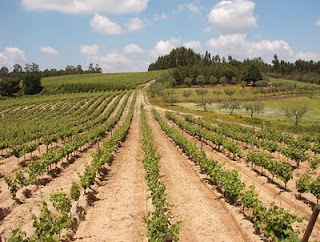It has been dry for more than two weeks now, in a season when we usually get most of our rain. Warm day time temperatures have continued to set local records for date over this period, and several of the local creeks that funnel our run-off into the Laguna's watershed are now dry. With many grape growers here just coming out of the worst growing season in memory, our abundant early season rains and mountain snow fall must have seemed like a blessing. Now the rains have stopped. Perhaps it is a good time to assess where we are, and where we are going.
- Local grower, Rick, proudly announced recently that all of his estates premium Chardonnay and Pinot Noir vines had already competed their dormant season pruning. Continuing dry weather has allowed his vineyard workers to focus on other maintenance, like re-securing the arms or cordons to their guide wires.
- John, who has been growing wine grapes for more than a generation on the family farm, said that he has had vine health issues in the past on his Chardonnay. Pruning wounds can invite systemic fungal infestations or bacterial infections like Pierce's Disease, so he won't prune anything until just before bud break. My few ornamental vines of late-season ripening Syrah and Cabernet Sauvignon, are already showing signs of the Spring bud break due to the false Spring-like conditions here.
Mixed Messages; At the recent Unified Wine & Grape Symposium, it was announced that demand for California wines continue to increase, and have resulted in as much as an additional 17,000 acres planted in the last year alone. In addition to perennial favorites, hot new varieties include Muscat of Alexandria and Pinot Grigio. Take heart and raise a glass white wine drinkers!
- Wine industry expert, Bill Turrentine, reports that far and away the U.S. is the most lucrative wine market in the world, and expects that we will account for as much as 19% of global consumption by 2030. That figure is more than double our world market share in 1980! Keep drinking those value based imports, because they know we are here!!
- It was also reported that high end(+$20) wine sales grew significantly in the last quarters of 2010, but that North Coast wine grape production fell again, about 20%, due to an erratic and challenging growing season.With the State grape harvest down, there could be a significant shortage of some wine grape varieties ahead. So, drink it now, for it may not be that bargain in the future!
- Allied Grape Growers President DiBuduo notes that most Sonoma County AVA grape growers only produce about three(3) tons per acre, while the average cost of farming those acres is about $12,000, annually. Based on 2009 prices, a grower would need to harvest about 5.6 tons per acre to break even! California, the Sunshine State, continues to produce about 90% of the nations wine, followed in production by Washington and New York. Domestic price increases should be anticipated by consumers, so stock up now!
More than half of California's production comes from the Central Valley, home of generic table and bulk wines. The states 2005 wine grape harvest set a new benchmark, more than 3.15 million tons, with Cabernet Sauvignon and Chardonnay acreage leading the way. Each of the last five(5) harvests produced less and less premium fruit, but our wine consumption as a nation continues to grow. I must be drinking more!
- One of the nation's most prestigious wine judgings, the San Francisco Chronicle Wine Competition, was held recently at the City's Fort Mason Center. Paso Robles AVA of California's Central Coast, was the big winner among the wines of 23 states entered. Sweepstakes awards for best White was given to a New Mexico Gewurztraminer, and the best Rose' was judged to be from Washington state. Of the 27 White Wine Best of Class winners, only five(5) came from Sonoma county.
Summarizing, we are growing more higher quality fruit and importing more wines in California than ever before, but we are also drinking more too. Costs relative to producing those domestic wines continues to climb, but, so too does the competition with ever increasing foreign markets. Savvy wine shoppers will continue to ferret out quality values, and after years of belt-tightening, local growers should have an easier time going forward, if only Mother Nature will cooperate. And, North Coast AVA wine producers should expect that even though we consumers are drinking more premium wines than ever before, more of it will come from outside our backyard and arrive at our dining tables everyday.
And, I still don't know if I should prune my grape vines. Finally, rain is in our forecast.
Now that's a Bramble! Cheers!!









